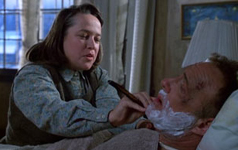Misery [DVD]
|
 Hollywood's courtship of horror novelist Stephen King started off so well. Their first date produced Carrie (1976), an over-the-top masterpiece of teen-anguish horror directed by Brian De Palma with such flair and style that both he and King became instant pop-culture stars. Over the next few years King's increasingly prolific literary output attracted the talents of horror-cinema icons like Tobe Hooper (1979's Salem's Lot), George A. Romero (1982's Creepshow), and David Cronenberg (1983's The Dead Zone), as well as cinematic titan Stanley Kubrick, whose 1980 filmic version of The Shining may not have suited King's tastes, but has proved to be one of the most endlessly fascinating horror films of the past few decades.
Hollywood's courtship of horror novelist Stephen King started off so well. Their first date produced Carrie (1976), an over-the-top masterpiece of teen-anguish horror directed by Brian De Palma with such flair and style that both he and King became instant pop-culture stars. Over the next few years King's increasingly prolific literary output attracted the talents of horror-cinema icons like Tobe Hooper (1979's Salem's Lot), George A. Romero (1982's Creepshow), and David Cronenberg (1983's The Dead Zone), as well as cinematic titan Stanley Kubrick, whose 1980 filmic version of The Shining may not have suited King's tastes, but has proved to be one of the most endlessly fascinating horror films of the past few decades.
Then the bottom started to drop out of the relationship. Perhaps Hollywood and King were seeing too much of each other, but their collaborative projects started falling rapidly in quality. John Carpenter (Halloween) foundered on the rocky shoals of the possessed-car movie Christine (1983), Firestarter (1984) fizzled, Silver Bullet (1985) was almost embarrassingly unscary, and King himself foisted on the public his directorial debut Maximum Overdrive (1986), which is surely one of the worst Stephen King movies of all time. But then, in 1986, a strange thing happened: One of the best Stephen King movies ever made was released, and many people didn't even realize it was based on a Stephen King story. Directed by Rob Reiner, Stand by Me, a nostalgic tale about four best buddies on a trip to find a dead body, became an instant sleeper-classic and broke the mold of what a "Stephen King movie" could be. Unfortunately, there were plenty more duds to come (Graveyard Shift, anyone?), which is why when Reiner signed on to direct the film version of King's 1988 novel Misery, with Oscar-winning screenwriter William Goldman on keyboard, it was a welcome bid to resuscitate the bloated and dying King oeuvre. James Caan stars as Paul Sheldon, a novelist who has made a fortune writing a series of romantic novels featuring a resilient heroine named Misery Chastain. Determined to be a serious novelist, he has just finished his first non-Misery novel and is driving back from the mountain lodge where he ritualistically finishes all his projects when he skids off the road in a snowstorm and crashes. He is rescued by Annie Wilkes (Kathy Bates), his self-proclaimed number one fan who was aware of his accident because she was following him. Annie happens to be a former nurse, so she takes him back to her house, bandages and splints his two horribly broken legs, pops his dislocated shoulder back into place, and then keeps him prisoner in the house, demanding that he write a new Misery novel since he had the gall to kill the heroine at the end of the last one (when Paul tries to explain that Misery "died in childbirth," Annie shrieks in reply "You killed her!"). Annie's tenuous grasp on the distinction between fiction and reality is only one element that makes her mentally deranged character so frightening. A physically imposing woman (Reiner often shoots Bates from low angles, making her look all the more menacing), she is always one word from slipping over the precarious edge that demarcates her seemingly split personality. She can be kind, gentle, and even sweet and a bit charming, but in an instant all of that can evaporate in a haze of anger, resentment, and unbridled aggression. Paul's survival strategy hinges on his ability to keep Annie placated, which proves to be virtually impossible given her hair-trigger temper and complete disassociation of right and wrong. Paul is both her prized possession and her improvement project; she is determined to show him that he was born to write Misery novels, even if that involves forcing him to burn his new manuscript in a charcoal grill and later "hobbling" him with a sledgehammer in the film's most notoriously cringe-inducing sequence. King wrote the original novel as a response to his own feelings of entrapment by his enormous and often ravenous fan base, and anyone who has ever been the object of unwelcome attention will immediately identify. At the same time, though, King also created a telling portrait of the male fear of female emasculation. After all, the relationship between Paul and Annie is in many ways a nightmarish exaggeration of male-female relationships in general, with Paul's imprisonment as a literalization of men's fears of being tied to the home, constantly afraid of saying or doing the wrong thing lest they unleash a perfect emotional storm from their spouse (the very first time Annie blows up at him, she ends with, "There! See what you made me do?"). Thus, Annie herself is a somewhat problematic character, as she is clearly the product of a man's pen--all feminine fury and irrationality. Although Reiner had never directed a thriller before (his most recent film at the time was When Harry Met Sally … (1989), he shows an inherent understanding of what makes the genre tick. Like Jonathan Demme did a year later in The Silence of the Lambs (1991), Reiner turns Misery into a horrorshow of close-ups. Given the limited setting (most of the film takes place inside Annie's house) and only two principal characters to work with, Reiner turns to close-ups of Paul and Annie's faces to depict the parameters of their constant psychological tug-of-war. We can see every element of the transition when Kathy Bates's round, smooth face morphs from almost childlike enthusiasm to psychotic rage; it's no small surprise that she won the Oscar for Best Actress that year, as her performance creates exactly the kind of palpable tension and unease that makes the film work. Caan is just as good, emphasizing the frustration of Paul's physical impotence even as his mind is constantly working, trying to figure some way out of his bizarre situation. This leads, of course, to several nail-biting sequences, including one in which he manages to escape from his room and has to beat a hasty retreat when he hears Annie arriving unexpectedly early. Screenwriter William Goldman, with whom Reiner had worked on The Princess Bride (1988), keeps the best parts of King's novel, tones down some of his graphic excesses (the hobbling scene involves an axe in the novel, rather than a sledgehammer), and also adds a subplot involving a folksy police detective (Richard Farnsworth) and his randy wife (Frances Sternhagen) searching for Sheldon. The new subplot is a welcome addition, and Goldman works it so that it provides some comic relief from the tension inside Annie's house without defusing the situation entirely. Farnsworth and Sternhagen are old pros, and they develop an amusing comic banter that plays as counterpoint to the twisted perversity of Annie's in-her-own-mind romantic obsessions with Paul. The film builds and builds, gathering steam until the final explosion, which is as breathlessly cathartic as it is brutally inevitable.
Copyright ©2007 James Kendrick Thoughts? E-mail James Kendrick All images copyright © MGM / 20th Century Fox Home Entertainment | |||||||||||||||||||||||||||||||||||||
Overall Rating:



 (3.5)
(3.5)
Subscribe and Follow
Get a daily dose of Africa Leader news through our daily email, its complimentary and keeps you fully up to date with world and business news as well.
News RELEASES
Publish news of your business, community or sports group, personnel appointments, major event and more by submitting a news release to Africa Leader.
More Information
